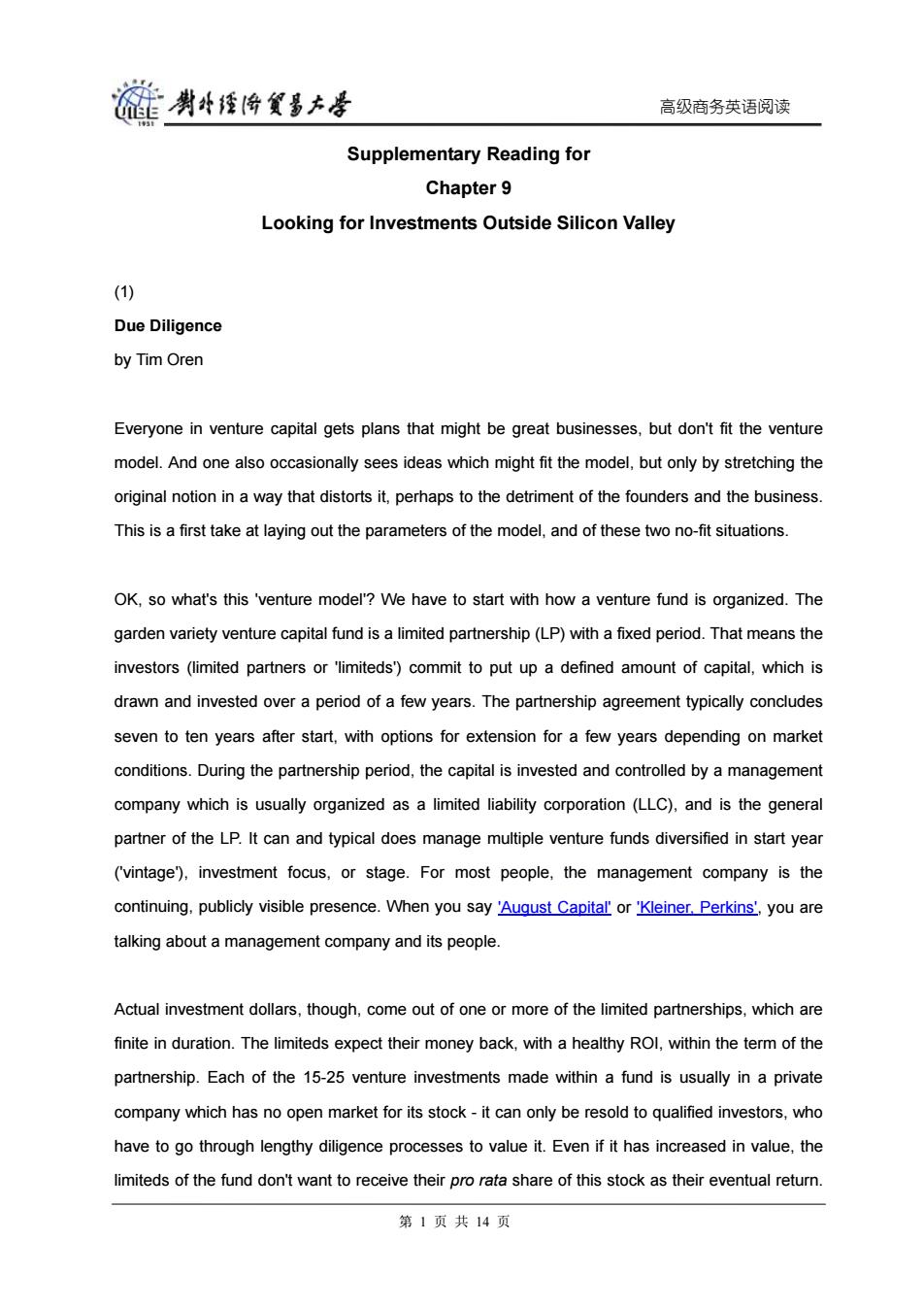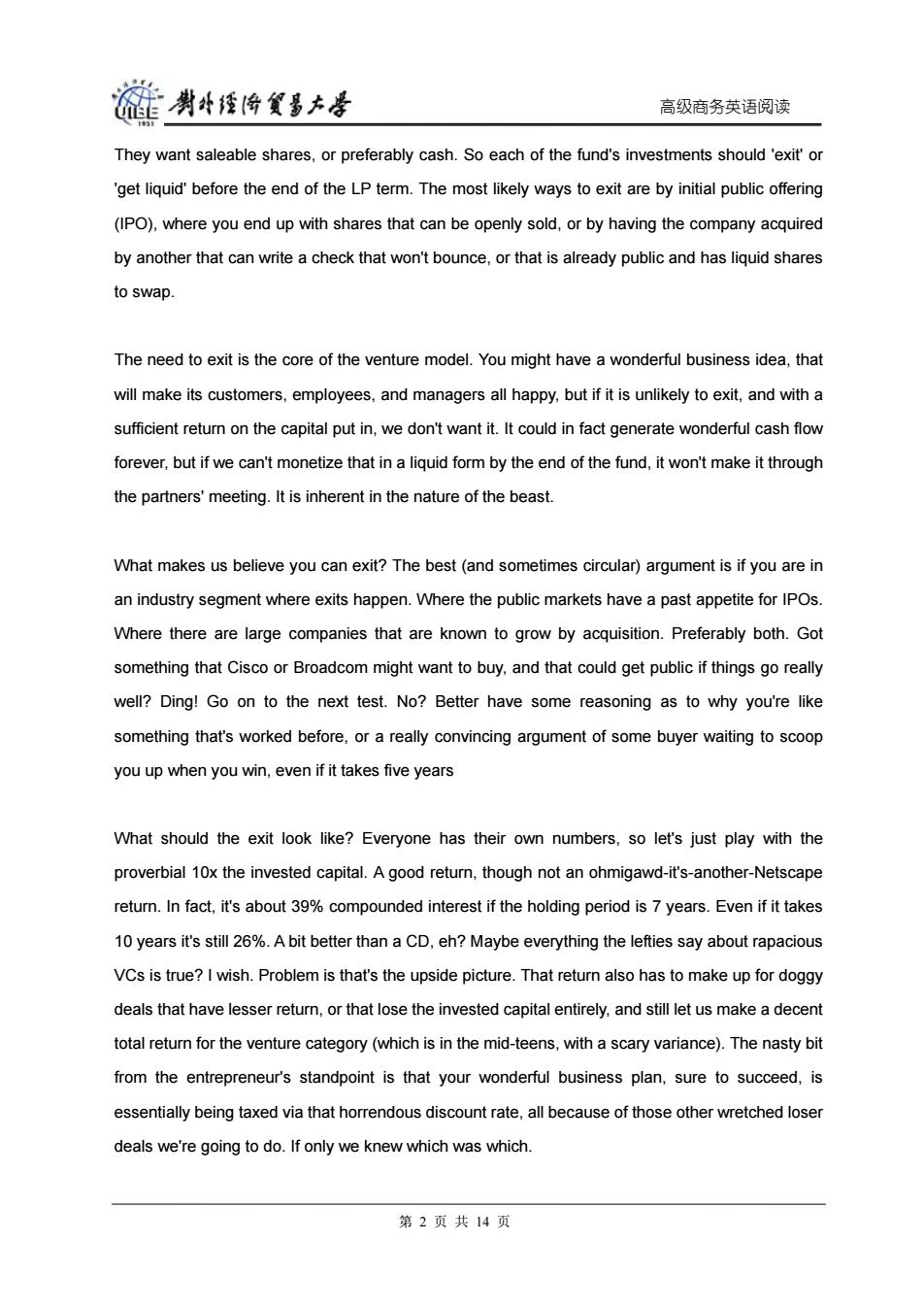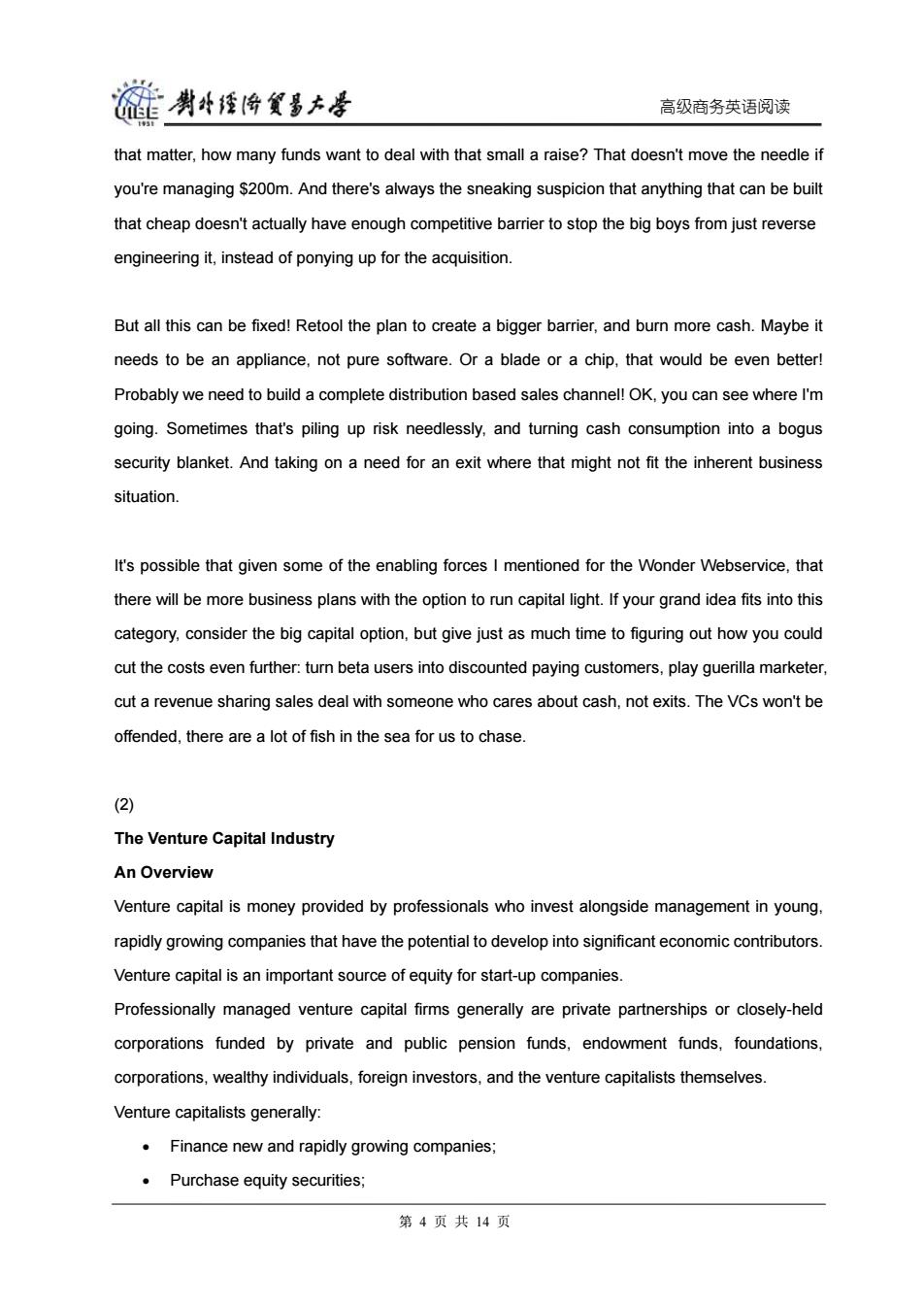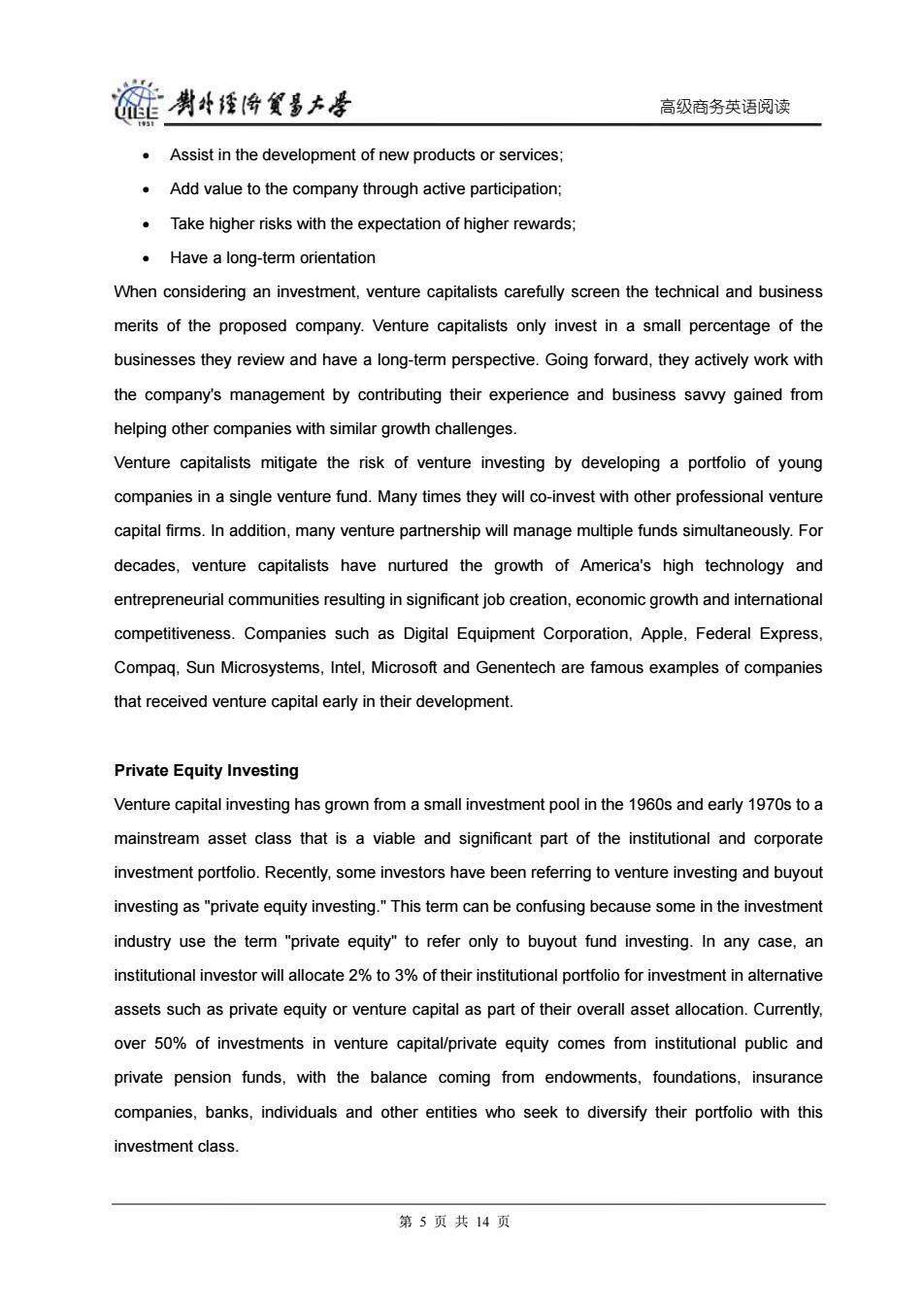
链典4矮降贸多大 高级商务英语阅读 Supplementary Reading for Chapter 9 Looking for Investments Outside Silicon Valley (1) Due Diligence by Tim Oren Everyone in venture capital gets plans that might be great businesses,but don't fit the venture model.And one also occasionally sees ideas which might fit the model,but only by stretching the original notion in a way that distorts it,perhaps to the detriment of the founders and the business. This is a first take at laying out the parameters of the model,and of these two no-fit situations OK,so what's this 'venture model'?We have to start with how a venture fund is organized.The garden variety venture capital fund is a limited partnership(LP)with a fixed period.That means the investors (limited partners or 'limiteds')commit to put up a defined amount of capital,which is drawn and invested over a period of a few years.The partnership agreement typically concludes seven to ten years after start,with options for extension for a few years depending on market conditions.During the partnership period,the capital is invested and controlled by a management company which is usually organized as a limited liability corporation (LLC),and is the general partner of the LP.It can and typical does manage multiple venture funds diversified in start year ('vintage'),investment focus,or stage.For most people,the management company is the continuing,publicly visible presence.When you say 'August Capital'or'Kleiner,Perkins',you are talking about a management company and its people. Actual investment dollars,though,come out of one or more of the limited partnerships,which are finite in duration.The limiteds expect their money back,with a healthy ROl,within the term of the partnership.Each of the 15-25 venture investments made within a fund is usually in a private company which has no open market for its stock-it can only be resold to qualified investors,who have to go through lengthy diligence processes to value it.Even if it has increased in value,the limiteds of the fund don't want to receive their pro rata share of this stock as their eventual return. 第1页共14页
高级商务英语阅读 Supplementary Reading for Chapter 9 Looking for Investments Outside Silicon Valley (1) Due Diligence by Tim Oren Everyone in venture capital gets plans that might be great businesses, but don't fit the venture model. And one also occasionally sees ideas which might fit the model, but only by stretching the original notion in a way that distorts it, perhaps to the detriment of the founders and the business. This is a first take at laying out the parameters of the model, and of these two no-fit situations. OK, so what's this 'venture model'? We have to start with how a venture fund is organized. The garden variety venture capital fund is a limited partnership (LP) with a fixed period. That means the investors (limited partners or 'limiteds') commit to put up a defined amount of capital, which is drawn and invested over a period of a few years. The partnership agreement typically concludes seven to ten years after start, with options for extension for a few years depending on market conditions. During the partnership period, the capital is invested and controlled by a management company which is usually organized as a limited liability corporation (LLC), and is the general partner of the LP. It can and typical does manage multiple venture funds diversified in start year ('vintage'), investment focus, or stage. For most people, the management company is the continuing, publicly visible presence. When you say 'August Capital' or 'Kleiner, Perkins', you are talking about a management company and its people. Actual investment dollars, though, come out of one or more of the limited partnerships, which are finite in duration. The limiteds expect their money back, with a healthy ROI, within the term of the partnership. Each of the 15-25 venture investments made within a fund is usually in a private company which has no open market for its stock - it can only be resold to qualified investors, who have to go through lengthy diligence processes to value it. Even if it has increased in value, the limiteds of the fund don't want to receive their pro rata share of this stock as their eventual return. 第 1 页 共 14 页

链剥挂将发多大是 高级商务英语阅读 They want saleable shares,or preferably cash.So each of the fund's investments should 'exit'or 'get liquid'before the end of the LP term.The most likely ways to exit are by initial public offering (IPO),where you end up with shares that can be openly sold,or by having the company acquired by another that can write a check that won't bounce,or that is already public and has liquid shares to swap. The need to exit is the core of the venture model.You might have a wonderful business idea,that will make its customers,employees,and managers all happy,but if it is unlikely to exit,and with a sufficient return on the capital put in,we don't want it.It could in fact generate wonderful cash flow forever,but if we can't monetize that in a liquid form by the end of the fund,it won't make it through the partners'meeting.It is inherent in the nature of the beast. What makes us believe you can exit?The best (and sometimes circular)argument is if you are in an industry segment where exits happen.Where the public markets have a past appetite for IPOs. Where there are large companies that are known to grow by acquisition.Preferably both.Got something that Cisco or Broadcom might want to buy,and that could get public if things go really well?Ding!Go on to the next test.No?Better have some reasoning as to why you're like something that's worked before,or a really convincing argument of some buyer waiting to scoop you up when you win,even if it takes five years What should the exit look like?Everyone has their own numbers,so let's just play with the proverbial 10x the invested capital.A good return,though not an ohmigawd-it's-another-Netscape return.In fact,it's about 39%compounded interest if the holding period is 7 years.Even if it takes 10 years it's still 26%.A bit better than a CD,eh?Maybe everything the lefties say about rapacious VCs is true?I wish.Problem is that's the upside picture.That return also has to make up for doggy deals that have lesser return,or that lose the invested capital entirely,and still let us make a decent total return for the venture category (which is in the mid-teens,with a scary variance).The nasty bit from the entrepreneur's standpoint is that your wonderful business plan,sure to succeed,is essentially being taxed via that horrendous discount rate,all because of those other wretched loser deals we're going to do.If only we knew which was which. 第2页共14页
高级商务英语阅读 They want saleable shares, or preferably cash. So each of the fund's investments should 'exit' or 'get liquid' before the end of the LP term. The most likely ways to exit are by initial public offering (IPO), where you end up with shares that can be openly sold, or by having the company acquired by another that can write a check that won't bounce, or that is already public and has liquid shares to swap. The need to exit is the core of the venture model. You might have a wonderful business idea, that will make its customers, employees, and managers all happy, but if it is unlikely to exit, and with a sufficient return on the capital put in, we don't want it. It could in fact generate wonderful cash flow forever, but if we can't monetize that in a liquid form by the end of the fund, it won't make it through the partners' meeting. It is inherent in the nature of the beast. What makes us believe you can exit? The best (and sometimes circular) argument is if you are in an industry segment where exits happen. Where the public markets have a past appetite for IPOs. Where there are large companies that are known to grow by acquisition. Preferably both. Got something that Cisco or Broadcom might want to buy, and that could get public if things go really well? Ding! Go on to the next test. No? Better have some reasoning as to why you're like something that's worked before, or a really convincing argument of some buyer waiting to scoop you up when you win, even if it takes five years What should the exit look like? Everyone has their own numbers, so let's just play with the proverbial 10x the invested capital. A good return, though not an ohmigawd-it's-another-Netscape return. In fact, it's about 39% compounded interest if the holding period is 7 years. Even if it takes 10 years it's still 26%. A bit better than a CD, eh? Maybe everything the lefties say about rapacious VCs is true? I wish. Problem is that's the upside picture. That return also has to make up for doggy deals that have lesser return, or that lose the invested capital entirely, and still let us make a decent total return for the venture category (which is in the mid-teens, with a scary variance). The nasty bit from the entrepreneur's standpoint is that your wonderful business plan, sure to succeed, is essentially being taxed via that horrendous discount rate, all because of those other wretched loser deals we're going to do. If only we knew which was which. 第 2 页 共 14 页

莲类4将发多大号 高级商务英语阅读 Now we can do a few numbers.For simplicity let's say there was one round of investment,of $15m, with a generous pre-money valuation of $9m.We now need a convincing case that a decently winning outcome will produce a total enterprise value of about $240m in five or six years-which we suspect will take a year or two longer anyway.Time to look for comparables:what were the price/sales or price/earnings(you should be so lucky!)ratios for recent IPOs or purchases in your category?Beyond the direct financial implications,these ratios have baked in a lot of market wisdom about margins,entry barriers,pricing power,and so forth.Higher is better.Let's just pick a whopping 3.0 price to sales,you lucky dog. So you need to book $80m in sales five to six years out.Now your Wonderful Widget takes 12 months to cook,even with prototype in hand.Year one revenue:$0.You sell the Wonderful Widget to an industry that turns over its products every 9 months,and has a three month typical sales cycle to its customers.Year two revenue:$250k for some samples and a bit of NRE.You closed two OEM customers,representing 15%of the total industry volume,but they only put it in their high end product.Year three revenue:$5m.Imagine these data points on a graph,along with year five/six:The 'hockey stick curve'is born.OK,we don't believe the specfic numbers on the chart any more than we do the Gartner numbers,but there had better be a good scale-up argument.Why an initial penetration can turn into a rapid breakout,and why your technology,sales channels, management team,and suppliers can all sustain that growth. That's a simplified picture,but it should show why some business types usually don't make it in normal times.Professional services?Low multiple.Market share game.Scales by hiring people, not running the fab line or CD press or download site.Next! That's one end of the game.Now the less common case.Suppose you actually could fit the model, but you only need(say)$1.5m of capital to create the Wonder Webservice.You'll get some chunks of the functionality on open source,plug into published APIs,get the protectable algorithm on a cheap license from your old university,and are just going to sell it through the net anyway,using a promotional model that can largely self-fund if it wins.If those stingy VCs only give you a premoney valuation of $2m,then if you're valued at $35m five years out,they ought to be happy!Well,maybe. Who ever heard of a $35m IPO anymore?Even the investment bankers aren't that hungry yet.For 第3页共14页
高级商务英语阅读 Now we can do a few numbers. For simplicity let's say there was one round of investment, of $15m, with a generous pre-money valuation of $9m. We now need a convincing case that a decently winning outcome will produce a total enterprise value of about $240m in five or six years - which we suspect will take a year or two longer anyway. Time to look for comparables: what were the price/sales or price/earnings (you should be so lucky!) ratios for recent IPOs or purchases in your category? Beyond the direct financial implications, these ratios have baked in a lot of market wisdom about margins, entry barriers, pricing power, and so forth. Higher is better. Let's just pick a whopping 3.0 price to sales, you lucky dog. So you need to book $80m in sales five to six years out. Now your Wonderful Widget takes 12 months to cook, even with prototype in hand. Year one revenue: $0. You sell the Wonderful Widget to an industry that turns over its products every 9 months, and has a three month typical sales cycle to its customers. Year two revenue: $250k for some samples and a bit of NRE. You closed two OEM customers, representing 15% of the total industry volume, but they only put it in their high end product. Year three revenue: $5m. Imagine these data points on a graph, along with year five/six: The 'hockey stick curve' is born. OK, we don't believe the specfic numbers on the chart any more than we do the Gartner numbers, but there had better be a good scale-up argument. Why an initial penetration can turn into a rapid breakout, and why your technology, sales channels, management team, and suppliers can all sustain that growth. That's a simplified picture, but it should show why some business types usually don't make it in normal times. Professional services? Low multiple. Market share game. Scales by hiring people, not running the fab line or CD press or download site. Next! That's one end of the game. Now the less common case. Suppose you actually could fit the model, but you only need (say) $1.5m of capital to create the Wonder Webservice. You'll get some chunks of the functionality on open source, plug into published APIs, get the protectable algorithm on a cheap license from your old university, and are just going to sell it through the net anyway, using a promotional model that can largely self-fund if it wins. If those stingy VCs only give you a premoney valuation of $2m, then if you're valued at $35m five years out, they ought to be happy! Well, maybe. Who ever heard of a $35m IPO anymore? Even the investment bankers aren't that hungry yet. For 第 3 页 共 14 页

碰剥经悔贸昌大是 高级商务英语阅读 that matter,how many funds want to deal with that small a raise?That doesn't move the needle if you're managing $200m.And there's always the sneaking suspicion that anything that can be built that cheap doesn't actually have enough competitive barrier to stop the big boys from just reverse engineering it,instead of ponying up for the acquisition. But all this can be fixed!Retool the plan to create a bigger barrier,and burn more cash.Maybe it needs to be an appliance,not pure software.Or a blade or a chip,that would be even better! Probably we need to build a complete distribution based sales channel!OK,you can see where I'm going.Sometimes that's piling up risk needlessly,and turning cash consumption into a bogus security blanket.And taking on a need for an exit where that might not fit the inherent business situation. It's possible that given some of the enabling forces I mentioned for the Wonder Webservice,that there will be more business plans with the option to run capital light.If your grand idea fits into this category,consider the big capital option,but give just as much time to figuring out how you could cut the costs even further:turn beta users into discounted paying customers,play guerilla marketer, cut a revenue sharing sales deal with someone who cares about cash,not exits.The VCs won't be offended.there are a lot of fish in the sea for us to chase. (2) The Venture Capital Industry An Overview Venture capital is money provided by professionals who invest alongside management in young, rapidly growing companies that have the potential to develop into significant economic contributors. Venture capital is an important source of equity for start-up companies. Professionally managed venture capital firms generally are private partnerships or closely-held corporations funded by private and public pension funds,endowment funds,foundations, corporations,wealthy individuals,foreign investors,and the venture capitalists themselves. Venture capitalists generally: Finance new and rapidly growing companies; Purchase equity securities: 第4页共14页
高级商务英语阅读 that matter, how many funds want to deal with that small a raise? That doesn't move the needle if you're managing $200m. And there's always the sneaking suspicion that anything that can be built that cheap doesn't actually have enough competitive barrier to stop the big boys from just reverse engineering it, instead of ponying up for the acquisition. But all this can be fixed! Retool the plan to create a bigger barrier, and burn more cash. Maybe it needs to be an appliance, not pure software. Or a blade or a chip, that would be even better! Probably we need to build a complete distribution based sales channel! OK, you can see where I'm going. Sometimes that's piling up risk needlessly, and turning cash consumption into a bogus security blanket. And taking on a need for an exit where that might not fit the inherent business situation. It's possible that given some of the enabling forces I mentioned for the Wonder Webservice, that there will be more business plans with the option to run capital light. If your grand idea fits into this category, consider the big capital option, but give just as much time to figuring out how you could cut the costs even further: turn beta users into discounted paying customers, play guerilla marketer, cut a revenue sharing sales deal with someone who cares about cash, not exits. The VCs won't be offended, there are a lot of fish in the sea for us to chase. (2) The Venture Capital Industry An Overview Venture capital is money provided by professionals who invest alongside management in young, rapidly growing companies that have the potential to develop into significant economic contributors. Venture capital is an important source of equity for start-up companies. Professionally managed venture capital firms generally are private partnerships or closely-held corporations funded by private and public pension funds, endowment funds, foundations, corporations, wealthy individuals, foreign investors, and the venture capitalists themselves. Venture capitalists generally: • Finance new and rapidly growing companies; • Purchase equity securities; 第 4 页 共 14 页

莲剥4将发多大号 高级商务英语阅读 Assist in the development of new products or services; Add value to the company through active participation; Take higher risks with the expectation of higher rewards; Have a long-term orientation When considering an investment,venture capitalists carefully screen the technical and business merits of the proposed company.Venture capitalists only invest in a small percentage of the businesses they review and have a long-term perspective.Going forward,they actively work with the company's management by contributing their experience and business savvy gained from helping other companies with similar growth challenges. Venture capitalists mitigate the risk of venture investing by developing a portfolio of young companies in a single venture fund.Many times they will co-invest with other professional venture capital firms.In addition,many venture partnership will manage multiple funds simultaneously.For decades,venture capitalists have nurtured the growth of America's high technology and entrepreneurial communities resulting in significant job creation,economic growth and international competitiveness.Companies such as Digital Equipment Corporation,Apple,Federal Express, Compaq,Sun Microsystems,Intel,Microsoft and Genentech are famous examples of companies that received venture capital early in their development. Private Equity Investing Venture capital investing has grown from a small investment pool in the 1960s and early 1970s to a mainstream asset class that is a viable and significant part of the institutional and corporate investment portfolio.Recently,some investors have been referring to venture investing and buyout investing as"private equity investing."This term can be confusing because some in the investment industry use the term "private equity"to refer only to buyout fund investing.In any case,an institutional investor will allocate 2%to 3%of their institutional portfolio for investment in alternative assets such as private equity or venture capital as part of their overall asset allocation.Currently. over 50%of investments in venture capital/private equity comes from institutional public and private pension funds,with the balance coming from endowments,foundations,insurance companies,banks,individuals and other entities who seek to diversify their portfolio with this investment class. 第5页共14页
高级商务英语阅读 • Assist in the development of new products or services; • Add value to the company through active participation; • Take higher risks with the expectation of higher rewards; • Have a long-term orientation When considering an investment, venture capitalists carefully screen the technical and business merits of the proposed company. Venture capitalists only invest in a small percentage of the businesses they review and have a long-term perspective. Going forward, they actively work with the company's management by contributing their experience and business savvy gained from helping other companies with similar growth challenges. Venture capitalists mitigate the risk of venture investing by developing a portfolio of young companies in a single venture fund. Many times they will co-invest with other professional venture capital firms. In addition, many venture partnership will manage multiple funds simultaneously. For decades, venture capitalists have nurtured the growth of America's high technology and entrepreneurial communities resulting in significant job creation, economic growth and international competitiveness. Companies such as Digital Equipment Corporation, Apple, Federal Express, Compaq, Sun Microsystems, Intel, Microsoft and Genentech are famous examples of companies that received venture capital early in their development. Private Equity Investing Venture capital investing has grown from a small investment pool in the 1960s and early 1970s to a mainstream asset class that is a viable and significant part of the institutional and corporate investment portfolio. Recently, some investors have been referring to venture investing and buyout investing as "private equity investing." This term can be confusing because some in the investment industry use the term "private equity" to refer only to buyout fund investing. In any case, an institutional investor will allocate 2% to 3% of their institutional portfolio for investment in alternative assets such as private equity or venture capital as part of their overall asset allocation. Currently, over 50% of investments in venture capital/private equity comes from institutional public and private pension funds, with the balance coming from endowments, foundations, insurance companies, banks, individuals and other entities who seek to diversify their portfolio with this investment class. 第 5 页 共 14 页